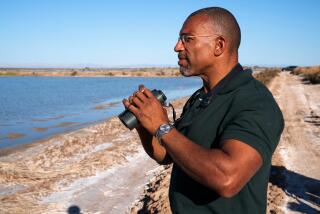Birdwatchers Flock to New Jersey Contest
- Share via
CAPE MAY, N.J. — In the World Series of Birding, people do the migrating.
Hoping to identify as many birds as possible in 24 hours, five-person teams came to New Jersey for a weekend in May to cough like a clapper rail and squint through binoculars.
A team sponsored by Carl Zeiss Optical in Alexandria, Va., captured the seventh annual birdwatching title by identifying 210 birds after racing over 490 miles.
“Stop! Please stop! Please stop the van!” shouted Julie Zickefoose, a bird illustrator from Hadlyme, Conn. “There’s a tern hovering.”
The group identified the bird within 10 seconds and shouted: “Drive on.”
“You don’t have time to enjoy the bird,” said Rick Radis, a writer from Denville, N.J., who was on the winning team. “It was: ‘There’s a stilt sandpiper. Let’s get back in the car.’ ”
Sponsored by the New Jersey Audubon Society, the contest began at 12:01 a.m. and ended the following midnight. The teams frantically crisscrossed hundreds of miles of New Jersey from pinelands to shore marsh.
Most started in northwestern New Jersey, relying on their ability to hear birds in the morning darkness. With daylight came a southward migration of birdwatchers, who hit the New Jersey shore tired but eager by midday. The competition ended on the tip of New Jersey’s southern shore in Cape May, a haven for migratory birds on their Atlantic flyway.
The state attracts a variety of birds because of its varying terrain of coastline, small mountains and pinelands. Its location between Canada and the southern United States also makes it possible to find birds from those areas.
On a sunny and windy afternoon--wind hampers birdcalls--the “birders” descended on the Edwin Forsythe National Wildlife Refuge in Oceanville, N.J.
The vans make their own formation by rumbling slowly along a dirt road until someone sights or hears a new bird species.
Teams operate on the honor system, and all members are required to have seen or heard the bird for it to be marked off. Five percent of the birds do not have to be identified by all members. This year, 253 birds were identified by the 35 teams. The clapper rail was heard but not seen.
Would a birder lie?
“It’s the last of the honor sports,” said Peter Alden, a tour group leader from New York City who has visited more than 100 countries and seen more than 5,000 bird species. “But you could have lied through your teeth, gotten up at 11 in the morning and figured out what you could have seen.”
Alden and Zickefoose’s group, which also included actress Jane Alexander, didn’t seem like the lying kind. Bird identification books littered their van, and three hours of travel with them showed their love for mastering the coughs that will draw out a clapper rail and for whipping out binoculars fast enough to spot a snowy egret.
The team ended up counting 168 birds, finishing 18th.
For the weekend at least, the camaraderie disappeared between birders who ordinarily would gladly show another that barn owl in the refuge’s pewter-colored waters set against the casino skyline of Atlantic City.
“At the end of the day, everybody kind of laughs at the bird you didn’t get,” said Alf Wilson, co-owner of a Walpole, Mass.-based company putting out a bird identification video.
Then he grew silent and cupped his ears while his teammates coughed, trying to attract the elusive clapper rail.
As for the winners, they credited their victory to 500 hours of advance scouting and simple birders’ luck at bird-spotting or “getting on the bird.”
For example, they found a red crossbill in northern New Jersey even though the migratory bird is not usually found in the state in spring or summer.
And members of the winning team--who got a team trophy and a pair of binoculars apiece--said they celebrated their victory by getting a jump on next year’s scouting. They got up early the next day and spotted a Mississippi kite.
“It’s for enjoyment, but it’s more of a game,” Radis said.
More to Read
Sign up for The Wild
We’ll help you find the best places to hike, bike and run, as well as the perfect silent spots for meditation and yoga.
You may occasionally receive promotional content from the Los Angeles Times.






